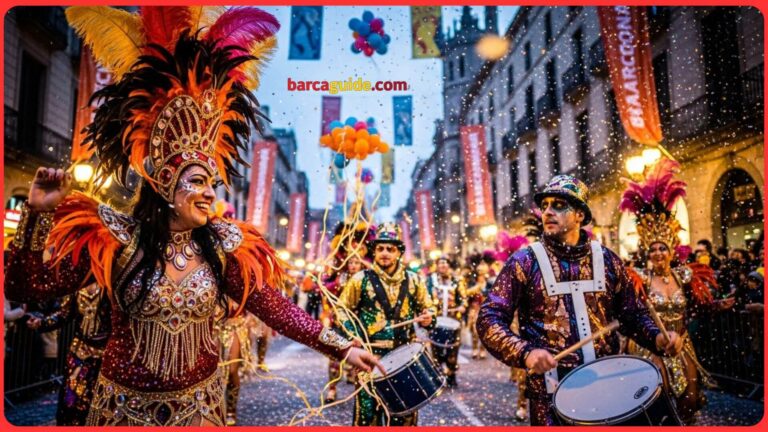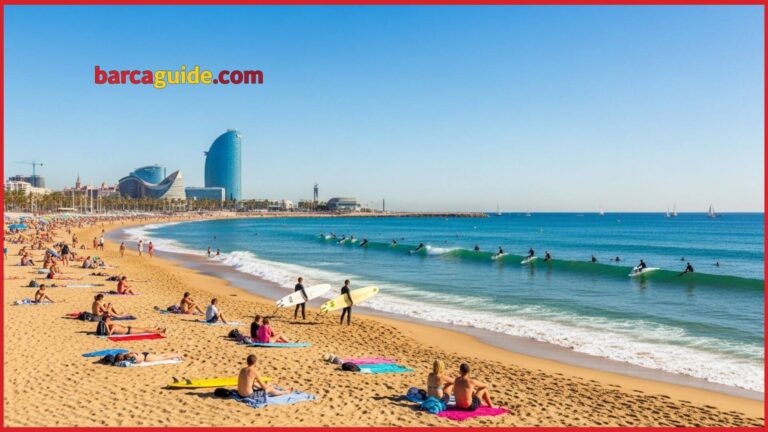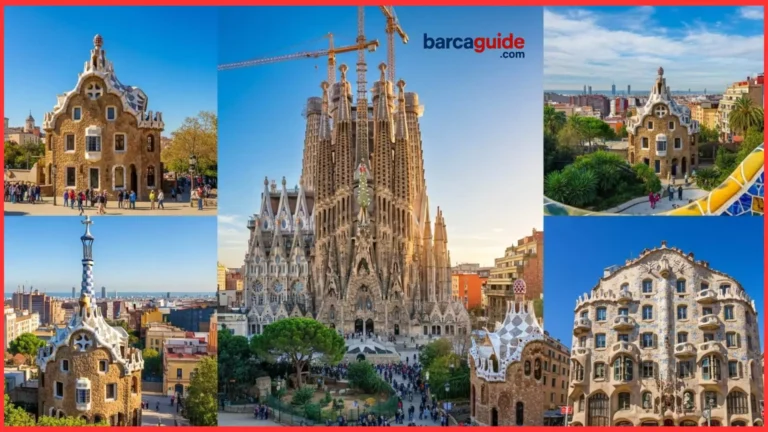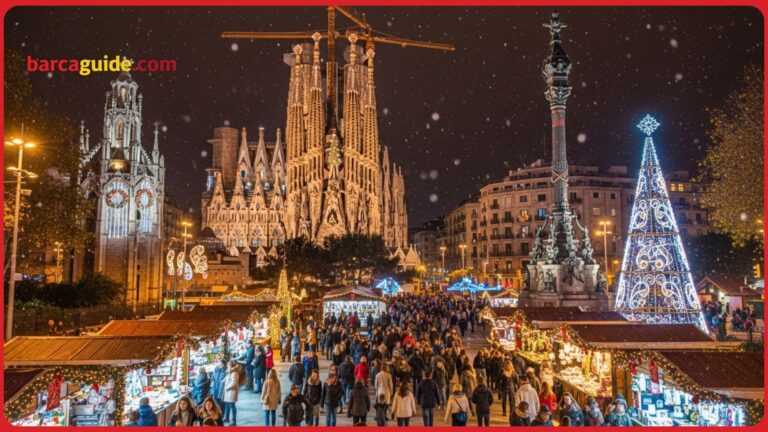Perfect Weekend in Barcelona: Tips for a Dream Getaway
So Barcelona is basically that friend who’s gorgeous, fun, cultured, AND knows how to cook. I mean, where else can you start your morning at a mind-blowing cathedral that’s been under construction for over 140 years, grab lunch at a medieval market, and end up sipping sangria on the beach watching the sunset? This city’s got it all figured out, and honestly, you’re gonna fall hard for it.
Why Barcelona Should Be Your Next Weekend Escape
It’s Like Three Vacations in One
Here’s the thing about Barcelona – it’s ridiculously overachieving. You’ve got ancient Roman ruins literally next to cutting-edge art galleries, and somehow it all just works. One minute you’re wandering through twisty medieval streets that look like they’re straight out of Game of Thrones, and the next you’re gawking at Gaudí’s wild, wavy buildings that look like they were designed by someone on a really good trip.
And can we talk about the beaches? You’re in a major European city with legit golden sand beaches right there! It’s like Barcelona looked at other cities and said, “Hold my beer, I’m gonna do culture AND coastline.” Plus, the weather’s pretty much perfect year-round – thanks, Mediterranean climate!
When to Actually Go (Without Melting or Going Broke)
I love Barcelona in the summertime, but unless you enjoy sweating through your shirt and battling tourists on every block for a fair photo, you may want to think about skipping July and August. July-August is the way to go, I mean you can’t beat the wonderful weather, the ability to not have to elbow tourists out of the way every step and your financial situation being weaped on few hundred less euros. Your sweet spot is in late spring (April-June) and early fall (September-October).
Summer’s fun if you’re all about that beach life and don’t mind the chaos, but honestly? Winter’s kind of a hidden gem. Fewer tourists, shorter lines, and you get to experience the city like locals do. Sure, you might not be lounging on the beach, but you’ll actually be able to get into that trendy restaurant without a reservation.
Getting There (And Not Getting Lost)
Flying In Like a Pro
Barcelona’s airport is super easy to deal with – it’s only about 20 minutes from the city center, which is basically a miracle in European airport terms. The Aerobús is your friend here – it’s like €6 and drops you right downtown. Or if you’re feeling fancy, the train’s even cheaper and almost as fast.
If you’re already in Europe, definitely consider the train. The high-speed rail from Madrid takes less than 3 hours, and you get to see some gorgeous countryside instead of being crammed into a tiny airplane seat. Plus, you arrive right in the city center, which is always a win.
Getting Around (Without Looking Like a Tourist)
The metro system is honestly fantastic – color-coded, clean, and it goes everywhere you need to go. Get a T-Casual card for 10 trips, and you’re set for the weekend. But here’s a pro tip: walk whenever you can. Barcelona’s built for strolling, and you’ll stumble across the coolest stuff just wandering around.
The city’s pretty bike-friendly too, though I’d skip the official bike-share program unless you’re staying longer (it’s for residents). Just rent one from a shop if you want to cruise along the waterfront – it’s actually really fun.
Day 1: The Greatest Hits (Plus Some Cool Surprises)
Morning: Sagrada Família (Prepare to Have Your Mind Blown)
HAVE to start with Sagrada Família. I don’t care if you think you’re not into churches – this thing is absolutely insane. Gaudí basically said “screw traditional architecture” and created something that looks like it grew out of the ground. Those columns inside? They’re supposed to look like trees, and honestly, they nailed it.
Book your tickets online beforehand or you’ll be crying in the plaza. The morning light streaming through those stained glass windows is pure magic – like being inside a kaleidoscope. Give yourself at least 1.5 hours, and if you’re not afraid of heights, definitely go up one of the towers. The views are incredible, and you’ll get some killer Instagram shots.
Midday: Gothic Quarter (Getting Gloriously Lost)
After your brain recovers from Sagrada Família, head to the Gothic Quarter. This place is like a medieval maze, and getting lost is half the fun. Seriously, just wander around and see what you find. The narrow streets are packed with history – we’re talking Roman walls, Gothic churches, and random beautiful courtyards that’ll make you stop in your tracks.
The Barcelona Cathedral is gorgeous (and free!), and there are actual geese living in the cloister, which is weirdly charming. Grab a coffee at one of the tiny cafés tucked into the old buildings – you’ll feel like you’ve discovered a secret spot.
Afternoon: Park Güell (Gaudí’s Playground)
After lunch, it’s time for more Gaudí madness at Park Güell. This place started as a fancy housing development that nobody wanted to live in, and now it’s one of the world’s coolest parks. Those colorful mosaic benches and the gingerbread house entrance? Pure whimsy.
The views from the main terrace are absolutely stunning – you can see the whole city spread out below you and the Mediterranean beyond. Just remember to book tickets for the fancy part online, or you’ll be stuck in the free areas (which are still pretty cool, but you’ll miss the iconic stuff).
Evening: Barceloneta Beach Vibes
End your day at Barceloneta, the old fishing neighborhood that’s now beach central. Find a chiringuito (beach bar) and order some sangria and tapas while watching the sunset. The grilled sardines are amazing, and the patatas bravas are dangerously addictive.
This is where you’ll really feel Barcelona’s vibe – locals and tourists all hanging out together, kids playing in the sand, people playing beach volleyball. It’s impossible not to relax here.
Day 2: Art, Food, and Beach Time
Morning: Picasso Museum and El Born
Start day two in El Born, which is basically the cool neighborhood your artsy friend would live in. The Picasso Museum is fantastic – it focuses on his early years in Barcelona, so you get to see how he developed his style. The museum’s in these gorgeous old medieval palaces, which is pretty awesome.
El Born itself is perfect for wandering – designer shops, cute cafés, and Santa Maria del Mar, which is this stunning Gothic church that’s way less crowded than the cathedral. The whole area just feels effortlessly cool.
Midday: Market Food Adventure
Time for a food adventure! Everyone talks about La Boqueria, and yeah, it’s famous for a reason, but it’s also touristy as hell. If you go, hit it early or late to avoid the crowds. For a more authentic experience, try Mercat de Santa Caterina – it’s got this crazy wavy roof and way more locals.
Either way, this is where you need to try pan con tomate (bread with tomato – sounds simple, tastes amazing), jamón ibérico, and whatever cheese looks good. Many markets have little tapas bars where you can eat surrounded by all the fresh ingredients. It’s heaven for food lovers.
Afternoon: Beach or Culture (Your Choice)
This is where you get to choose your own adventure. If it’s nice out, Barcelona’s beaches are calling. Barceloneta’s the most famous, but Nova Icària is a bit more chill. Grab a beach chair, order some drinks, and just soak up that Mediterranean sun.
Or if you’re feeling cultural, head up to Montjuïc hill. The Joan Miró Foundation is really cool, and the views from Montjuïc Castle are spectacular. Plus, if you take the cable car up, you’ll get some amazing photos of the city and harbor.
Night: Flamenco and Nightlife
Barcelona’s nightlife is legendary, and you should definitely experience it. Start with a flamenco show – even though it’s more of an Andalusian thing, Barcelona does it really well with its own Catalan twist. It’s passionate, dramatic, and honestly pretty mesmerizing.
Then head to El Raval for drinks. This neighborhood’s got everything from cozy wine bars to craft cocktail spots to dance clubs. Fair warning though – Spanish nightlife starts late. Like, really late. Don’t expect things to get going until after midnight.
Where to Sleep (Without Breaking the Bank)
Neighborhoods That Don’t Suck
The Eixample is probably your best bet – it’s got that cool grid layout so you won’t get lost, tons of restaurants, and you can walk to most attractions. Plus, all those Modernist buildings are pretty to look at.
If you want more character, the Gothic Quarter puts you right in the thick of things, though some of the buildings are ancient and might not have the best amenities. El Born is trendy and fun, while Gràcia gives you more of a local experience.
From Backpacker to Baller
Barcelona’s got options for every budget. If you’re splurging, the Hotel Casa Fuster is in this incredible Modernist building, and the W Barcelona looks like a giant sail on the beach (you can’t miss it).
For mid-range, there are tons of boutique hotels in converted historic buildings – you’ll get character and decent amenities. Budget travelers have great hostel options, especially in Gràcia and El Raval, and many offer private rooms if you don’t want to share with strangers.
Food: The Real Reason to Visit Barcelona
What You Actually Need to Eat
Forget everything you think you know about Spanish food – Catalan food is a different game entirely. You will find pan con tomate (bread with tomato) at every meal and once you try it, you will understand why. It is only bread, tomato, olive oil, and salt, but somehow it is addicting.
You will also want to try the seafood, suquet de peix (fish stew) is exceptional, and arròs negre (black rice) looks a little scary but tastes unbelievably good. For dessert, crema catalana is like the cooler cousin of crème brûlée.
Where to Actually Eat
For tapas, Cal Pep in El Born is legendary (but tiny and there’s always a wait). Quimet & Quimet is this hole-in-the-wall place with incredible small plates – you’ll be standing and eating, but it’s worth it.
If you want to splurge, Barcelona’s got some seriously good restaurants. But honestly? Some of the best meals I’ve had were at random neighborhood spots. Don’t be afraid to eat where the locals eat.
Shopping (Beyond Tourist Traps)
Markets and Streets Worth Your Time
La Boqueria is famous but touristy. For a more authentic market experience, try the smaller neighborhood ones. Passeig de Gràcia is the fancy shopping street – think Champs-Élysées but with better architecture. For unique finds, wander through the Gothic Quarter’s narrow streets.
Stuff Worth Bringing Home
Espadrilles (those rope-soled shoes) are classic Spanish souvenirs that you’ll actually wear. Local ceramics are gorgeous, and if you’re a foodie, jamón ibérico and Spanish olive oil make great gifts (just check customs rules).
Staying Safe (And Not Looking Like a Tourist)
Watch Out for These Scams
Barcelona’s pretty safe, but pickpockets are everywhere, especially on Las Ramblas and around major attractions. Keep your stuff zipped up and don’t flash expensive jewelry or electronics.
The classic scams to avoid: the “gold ring” trick (someone “finds” a ring and tries to sell it to you), distraction techniques where one person talks to you while another grabs your stuff, and any street games. If someone’s being overly friendly in a tourist area, be suspicious.
Blending In 101
Learn a few words in Catalan – “Bon dia” (good morning) and “Moltes gràcies” (thank you) will get you smiles. Remember that lunch is late (after 1:30 PM) and dinner is really late (after 9 PM). Many shops close for siesta from 2-5 PM.
Money Talk (How Much You’ll Actually Spend)
The Real Numbers
Barcelona’s way cheaper than London or Paris, but it’s not Prague. Budget travelers can do it for €40-60 per day if you stay in hostels and eat at markets. Mid-range is more like €80-120 per day for decent hotels and restaurant meals.
If you’re going luxury, expect €150-250+ per day. Most attractions cost €10-25, and a metro day pass is under €10. Restaurant meals range from €8-15 for lunch deals to €25-40 for dinner.
How to Save Without Being Miserable
The Barcelona Card offers discounts and free transport but do the math – it’s not always worth it. Many museums are free on the first Sunday of the month. Lunch menus (menú del día) are excellent value and amazing – typically multi-course meals for €10-20.
Buy groceries at markets for picnics, and take advantage of happy hour specials. The beaches and parks are free entertainment!
Hidden Gems (The Cool Stuff Locals Know)
Places Your Instagram Friends Haven’t Been
Skip the crowded tourist viewpoints and head to Bunkers del Carmel – these old anti-aircraft bunkers have the best views in the city with way fewer people. The Hospital de la Santa Creu i Sant Pau is this incredible Modernist complex that most tourists miss.
Discover Gràcia’s little squares – each has its own character and great local bars. The Parc del Laberint d’Horta has beautiful gardens and the oldest maze in Spain.
Secret Spots and Quiet Corners
The roof terrace at Palau de la Música Catalana has amazing views and hardly anyone knows about it. Some apartment buildings in Eixample have legal rooftop access during certain hours – ask your hotel about it.
For quiet moments, try the cloister at Pedralbes Monastery or the hidden Roman walls near Plaça Ramon Berenguer el Gran. Even the cemetery on Montjuïc is surprisingly peaceful and artistic.
Apps You’ll Actually Use
The Essential Downloads
TMB app for metro times and updates – super useful. Google Maps obviously, but Citymapper is even better for public transport. TheFork for restaurant reservations, and Google Translate’s camera function is magic for reading menus.
Download offline maps before you go – you’ll save on data and won’t be stuck when the wifi’s bad.
If You’re Bringing Kids
Stuff They’ll Actually Enjoy
Barcelona’s pretty family-friendly. The zoo in Ciutadella Park is great, and kids love the interactive exhibits at CosmoCaixa science museum. Tibidabo amusement park has vintage rides and crazy good views.
The beaches are obviously a hit with families, and there’s equipment rental everywhere. Just remember to bring sunscreen – the Mediterranean sun is stronger than you think.
Making It Work for Everyone
Start later in the day to work with kids’ schedules, and plan picnic lunches in parks so everyone can recharge. Look for hotels with kitchenettes so you can have familiar food options. Many museums have family programs that make culture more engaging for kids.
Seasonal Stuff (What Changes When)
How Weather Affects Your Trip
Spring is gorgeous – mild weather, markets full of flowers, perfect for walking. Summer means beach culture and late nights, but also heat and crowds. Fall is ideal for sightseeing with fewer tourists. Winter’s actually lovely – mild temperatures, holiday decorations, and a more local feel.
Cool Events to Time Your Visit Around
The Festa Major de Gràcia in August is incredible – the whole neighborhood decorates their streets with elaborate themes. La Mercè festival in September has parades and concerts. Sant Jordi’s Day (April 23) fills the streets with book and flower stalls – it’s like Valentine’s Day but cooler.
What to Pack (And What to Leave Home)
Actually Useful Stuff
Comfortable walking shoes are non-negotiable – you’ll be doing a lot of walking on everything from cobblestones to beaches. Layer-able clothes work best since you’ll be going from air-conditioned museums to warm streets.
A light jacket for evenings (Mediterranean breezes can be cool), sun protection, and a small daypack for carrying water and snacks. Oh, and a portable phone charger – you’ll be taking tons of photos.
Don’t Bother Bringing
Skip the fancy clothes – Barcelona’s pretty casual even at nice restaurants. Heavy jackets are only needed in winter. Don’t bring expensive jewelry or anything flashy. Beach stuff can be rented, and heavy guidebooks are useless when you have a smartphone.
The Bottom Line
Why You’ll Want to Move There
Barcelona is not a destination you visit – it is a city that infiltrates your soul. The unique blend of stunning architecture, fabulous cuisine, picturesque beaches and relaxed Mediterranean approach to life, creates something magical. You will find yourself sitting in a café at 11 PM and watching people meander by saying to yourself “I could get used to this”.
The key is to not try to see everything. Pick a few must-sees, but leave time to wander and discover. Barcelona rewards curiosity – that random tapas bar you stumble into might serve the best meal of your trip.
Remember that this is a real city where people live and work, not just a tourist playground. Be respectful, learn a few words in Catalan, and you’ll find that Barcelona opens up to you in ways you never expected.
Trust me, you’ll be planning your return trip before you even leave.
Quick Answers to Your Burning Questions
When’s the best time to visit? April-June or September-October. Great weather, fewer crowds, reasonable prices. Summer’s fun but crazy crowded, winter’s underrated but you’ll miss the beach scene.
Is 2-3 days enough? Great if you’re just looking for the highlights and experiencing the city. It would be easy to drop a week here, but a weekend gives you enough time to fall in love with the place.
Is it safe to travel alone? Totally! Just use common sense – don’t flash expensive stuff, stay aware in crowds, and trust your instincts. The city’s walkable and the transport’s great.
What absolutely can’t I miss? Sagrada Família, Park Güell, Gothic Quarter, and eating tapas. Also, just wandering through the markets and sitting on the beach with a drink. That’s Barcelona right there.
Can I do this on a budget? Absolutely! Stay in hostels, eat at markets, take advantage of free museum hours, and walk everywhere. The best parts of Barcelona – the beaches, parks, and just soaking up the atmosphere – don’t cost anything.







